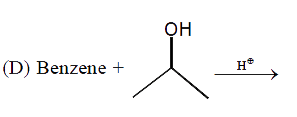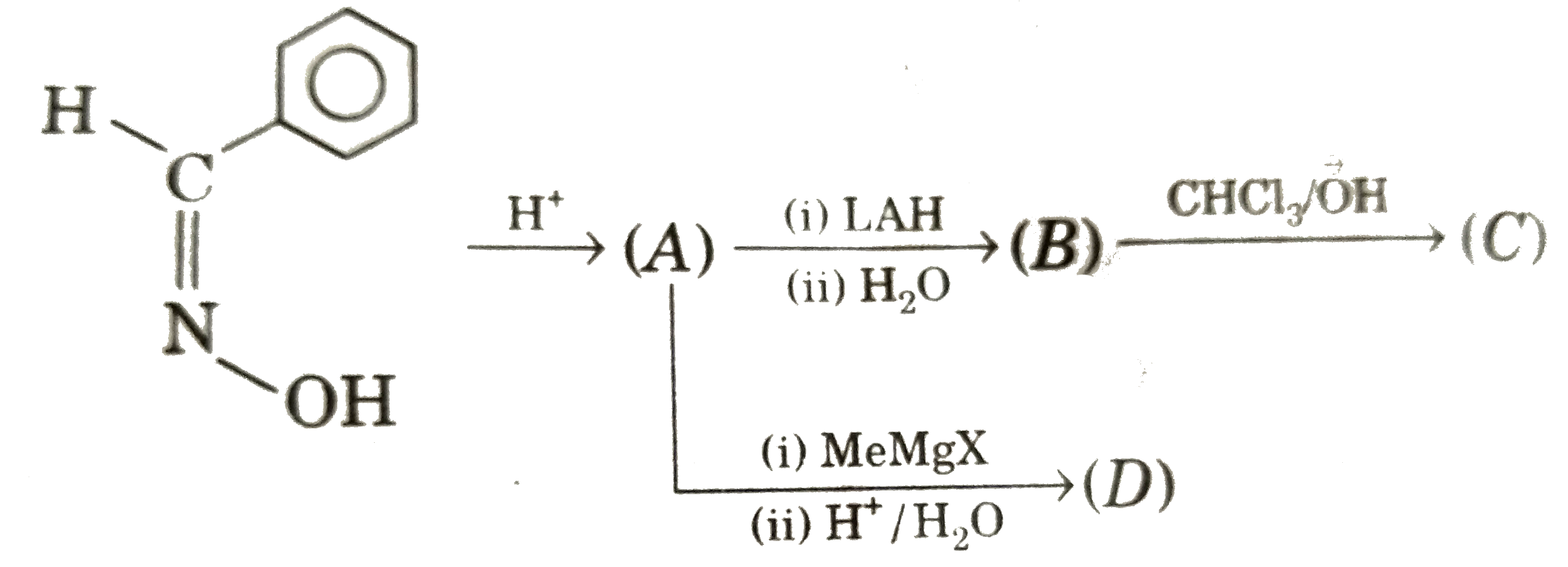Isopropylbenzene can be prepared by :
Benzene +CH3CH=CH2H2SO4−−−→
Benzene +CH3−C∣ClH−CH3AlCl3−−→


The correct Answer is:A, B, C, D
To prepare isopropylbenzene (also known as cumene), we can follow a series of steps that involve the reaction of benzene with an appropriate alkyl halide or alcohol in the presence of a catalyst. Here’s a step-by-step breakdown of the process:
Step 1: Identify the Components
We need to start with benzene (C6H6) and an isopropyl group (C3H7). The isopropyl group can be introduced via isopropyl chloride (C3H7Cl) or isopropanol (C3H8O).
Step 2: Choose the Reaction Method
There are several methods to prepare isopropylbenzene:
1. Friedel-Crafts Alkylation: This involves the reaction of benzene with isopropyl chloride (or isopropanol) in the presence of a Lewis acid catalyst like AlCl3.
2. Hydride Shift: If starting from a secondary alcohol, we can use acid to protonate the alcohol, leading to the formation of a carbocation, which can then rearrange to form a more stable carbocation before reacting with benzene.
Step 3: Friedel-Crafts Alkylation
1. React Benzene with Isopropyl Chloride:
- Combine benzene (C6H6) with isopropyl chloride (C3H7Cl) in the presence of AlCl3.
- The AlCl3 acts as a catalyst and helps generate the isopropyl carbocation (C3H7+).
Reaction:
C6H6+C3H7ClAlCl3−−−→C6H5C3H7+HCl
Step 4: Carbocation Stability
- The isopropyl carbocation is a secondary carbocation, which is more stable than a primary carbocation. Thus, it can effectively react with the benzene ring.
Step 5: Nucleophilic Attack
- The benzene ring acts as a nucleophile and attacks the isopropyl carbocation, leading to the formation of isopropylbenzene.
- The aromaticity of the benzene is restored by the loss of a proton (H+).
Step 6: Final Product
- The final product is isopropylbenzene (C6H5C3H7), which is also known as cumene.
Conclusion
Isopropylbenzene can be prepared through Friedel-Crafts alkylation using benzene and isopropyl chloride in the presence of a Lewis acid catalyst like AlCl3.
We need to start with benzene (C6H6) and an isopropyl group (C3H7). The isopropyl group can be introduced via isopropyl chloride (C3H7Cl) or isopropanol (C3H8O).
There are several methods to prepare isopropylbenzene:
1. Friedel-Crafts Alkylation: This involves the reaction of benzene with isopropyl chloride (or isopropanol) in the presence of a Lewis acid catalyst like AlCl3.
2. Hydride Shift: If starting from a secondary alcohol, we can use acid to protonate the alcohol, leading to the formation of a carbocation, which can then rearrange to form a more stable carbocation before reacting with benzene.
1. React Benzene with Isopropyl Chloride:
- Combine benzene (C6H6) with isopropyl chloride (C3H7Cl) in the presence of AlCl3.
- The AlCl3 acts as a catalyst and helps generate the isopropyl carbocation (C3H7+).
Reaction:
C6H6+C3H7ClAlCl3−−−→C6H5C3H7+HCl
- The isopropyl carbocation is a secondary carbocation, which is more stable than a primary carbocation. Thus, it can effectively react with the benzene ring.
- The benzene ring acts as a nucleophile and attacks the isopropyl carbocation, leading to the formation of isopropylbenzene.
- The aromaticity of the benzene is restored by the loss of a proton (H+).
- The final product is isopropylbenzene (C6H5C3H7), which is also known as cumene.
Isopropylbenzene can be prepared through Friedel-Crafts alkylation using benzene and isopropyl chloride in the presence of a Lewis acid catalyst like AlCl3.
Topper's Solved these Questions
- AROMATIC COMPOUNDBOOK - MOTIONCHAPTER - AROMATIC COMPOUNDEXERCISE - Exercise - 3
17 Videos
- AROMATIC COMPOUNDBOOK - MOTIONCHAPTER - AROMATIC COMPOUNDEXERCISE - Exercise - 4 | Level-I
13 Videos
- AROMATIC COMPOUNDBOOK - MOTIONCHAPTER - AROMATIC COMPOUNDEXERCISE - Exercise - 2 (Level-I)
47 Videos
- ALKYI HALIDEBOOK - MOTIONCHAPTER - ALKYI HALIDEEXERCISE - Exercise - 4 | Level-II
8 Videos
- ATOMIC STRUCTURE BOOK - MOTIONCHAPTER - ATOMIC STRUCTURE EXERCISE - EXERCISE-4 (LEVEL-II)
18 Videos
Similar Questions
Knowledge Check

A can be prepared byAPh−C∣∣O−Cl+NH3→BPh−C∣∣O−Cl+NH3POCl3−−−→ΔC D
D
CO can be prepared by
Aheating HCOOH with conc. H2SO4Bheating K4[Fe(CN)6] with conc. H2SO4Cheating malonic acid with P2O5Dhydrolysis of Mn5C2Ketones can be prepared by :
AClemmesen's reducionBRosenmund's reductionCOppenauer's oxidationDCannizzaro's reaction.
